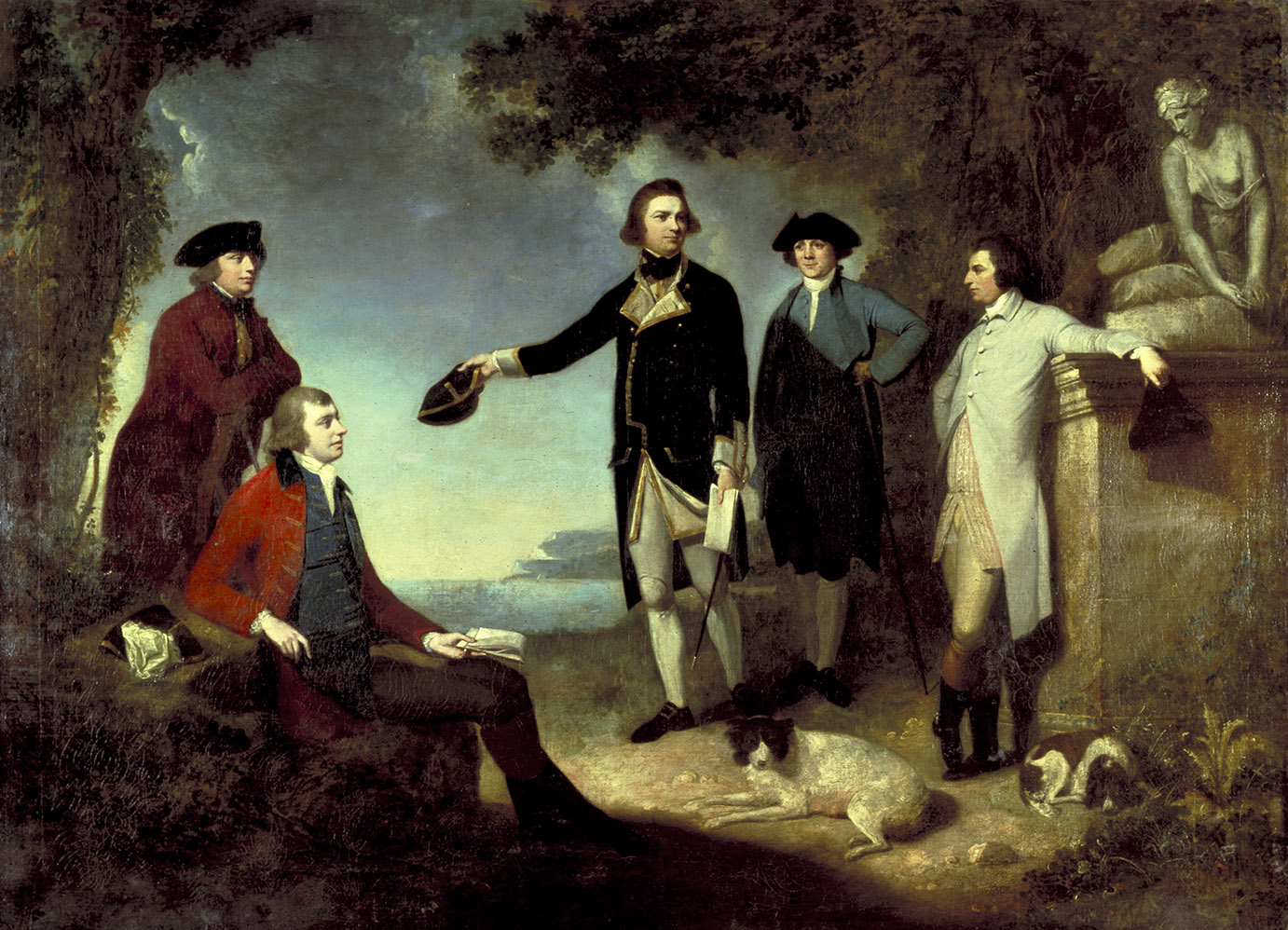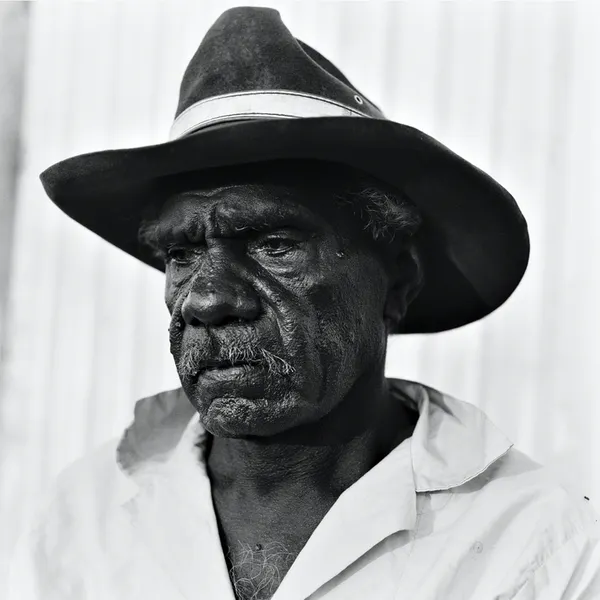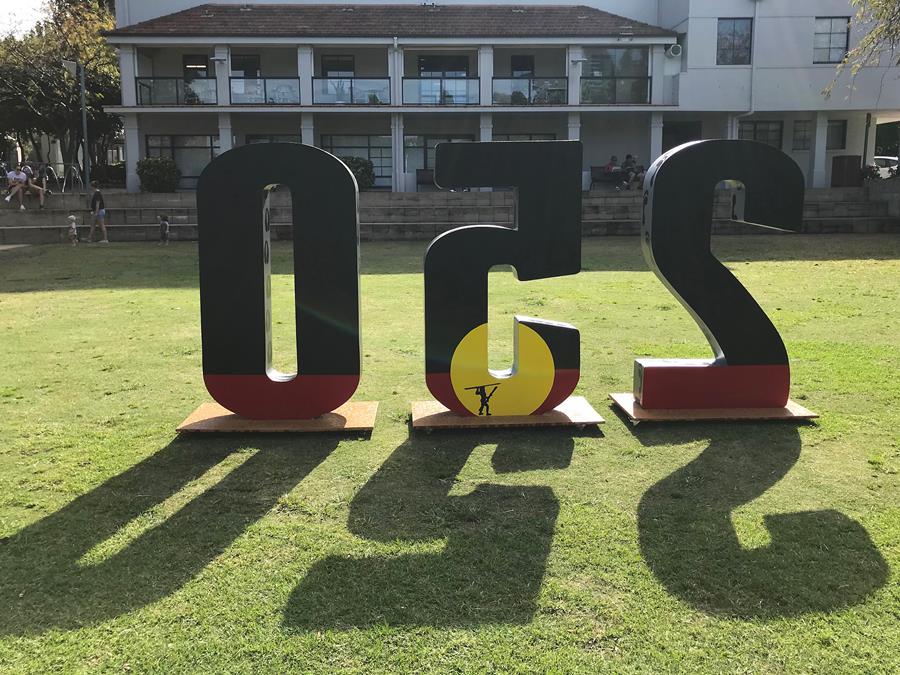Cooked???

John Hamilton Mortimer's extraordinarily bucolic version of Cook's possession of Australia, from left: Solander, Banks, Cook, Dr John Hawkesworth and Lord Sandwich, at the NMA
Posted by Jeremy Eccles | 29.04.20
Gallery: National Museum of Australia
Dates:
29.04.20
: 15.08.20
Today it's all about Captain Cook – though it may have been yesterday as the Botany Bay/Kamay Memorial of his landing dates it as 28th April; and, of course, he was but a Lieutenant at the time. But what an aura of division he still carries around his heroic shoulders - “invader”, “imperialist”, “killer”, “uncaring of the Gweagal man he shot”, etc.
Somehow, though, we've surely got to find a line between those who've built the good Captain's reputation skyhigh over the years using such excuses as Australia's Federation or the Bicentenary of 1770, and those who see his evil deeds as an excuse to cover his statue with pink paint as part of fighting the Land Rights fight or other important Indigenous battles. Too often, neither side has researched its case – by, for example, bothering to read the 700+ pages of Cook's own words from the 'Endeavour' voyage, or listened to the rich and complex Cook mythology that still persists across the Songlines of this land.
Take the words of Hobbles Danayarri, for instance. He was a Wave Hill man from the Northern Territory and a walk-offer, giving him moment to open his timeless mind to ethnographer Deborah Bird Rose. In 1984 she reported him explaining: “[Cook] should have asked him – one of these boss for Sydney – Aboriginal people. People were up there, Aboriginal people. He should have come up and: ‘hello’, you know, ‘hello’. Now, asking him for his place, to come through, because [it’s] Aboriginal land. Because Captain Cook didn’t give him a fair go – to tell him ‘good day’, or ‘hello’, you know”.
This I learnt from Maria Nugent on The Conversation. And she is Co-Director of the Australian Centre for Indigenous History at ANU, also the author of the 2005 book, 'Botany Bay – Where Histories Meet' and the later "Captain Cook Was Here" which all sides should have read – I think particularly of warring parties Peter FitzSimons relentlessly promoting his book on Cook in the Sydney Morning Herald, and Stan Grant, Waradjuri warrior responding with the surprisingly possessive 'The Captain James Cook I Know'.
Now, we know that Cook had firm instructions on how to handle himself when he “discovered” the Great Southern Land to ‘observe … the Natives’, and ‘by all proper means … cultivate a Friendship and Alliance with them … Shewing them every kind of Civility and Regard. You are also with the Consent of the Natives to take Possession of Convenient Situations in the Country in the Name of the King of Great Britain: Or: if you find the Country uninhabited, take Possession for his Majesty by setting up Proper Marks and Inscriptions, as first discoverers and possessors”.
He also had to bear in mind advice regarding the said 'Natives' from Lord Morton, President of the Royal Society which was sponsoring his expedition: “They are the natural, and in the strictest sense of the word, the legal possessors of the several Regions they inhabit. No European Nation has a right to occupy any part of their country, or settle among them without their voluntary consent”! Not a mention of Terra Nullius – where did that come from??? It's never used by Cook.
So why did Alice Procter, provocateur and leader of 'Uncomfortable Art Tours' in the UK, promoting her book on ABC Radio National, accuse the sainted Cook of shooting bullets (actually buckshot) at the two Gweagal warriors who were painted up and armed to face these 'on-water arrivals' and not caring what damage he might have inflicted?
In fact Cook described the encounter in some detail in his diaries, reporting that his shot appeared to have no effect upon the victim apart from encouraging him to "lay hold of a Shield or target to defend himself". The famous Gweagal Shield now sits in the British Museum with what looks suspiciously to me like a bullet hole through it, and the Museum's Aboriginal curator ain't about to return it because there's actually a law against decluttering that august institution.
On another occasion, the thinking behind Cook's comments is a tad clearer: “We attempt to land in a peaceable manner, if this succeeds it's well. If not we land nevertheless and maintain the footing we thus got by the superiority of our fire arms. In what other light can they then at first look on us as invaders”. And that's a word most whitefellars really don't like to use. But Cook then spoils his case a bit: “Time and some acquaintance with us can only convince them of their mistake”!!!
If only Cook's Tahitian interpreter had understood the Gweagal cry of “warrawarrawa”. For its meaning isn't “Go away”, as it's often translated, but “They are all dead”.....ghosts of ancestors returning to haunt the living. Interestingly, “the warrawarras” was the name given by convicts to the Sydney people when the First Fleet arrived, even as they were sharing the COVID-1788 that killed so many of them.
Back to Dr Nugent, whose multi-racial researches suggests a surprising rationale for the stand-off that occurred at Gundal/Kernell. As Hobbles Danayarri hints, protocols were so different at this bottom end of the world. What has become the ubiquitous 'Welcome to Country' was a serious matter in the 1800s – and probably for 60,000s before that. And there was theatre to it. You ignored a visitor until such time as he made appropriate obeisance and requests entry. But when the theatrical rules were broken by firing a musket, that justified return fire with a stone and spears.
Cook did much better when he needed to land at Cooktown to repair the Endeavour. That lead to the locals symbolically breaking off a spear-tip to signify peace and satisfaction. And it was there that the good Lieutenant observed: “From what I have said of the Natives of New-Holland, they may appear to some to be the most wretched people upon Earth, but in reality they are far more happier than we Europeans; being wholy unacquainted not only with the superfluous but the necessary conveniencies so much sought after in Europe, they are happy in not knowing the use of them. They live in a Tranquillity which is not disturb’d by the Inequality of Condition: The Earth and sea of their own accord furnishes them with all things necessary for life; they covet not Magnificent Houses, Houshold-stuff”.
My god, he's a socialist!
I think today is an occasion to insist that he should be read – and am delighted to link you to the National Museum's online offering of his journal, below. The NMA also has an online exhibition, 'Endeavour Voyage' which is worth examining.
But I'd also like to note the equivocation that seems to lie behind the fact that in Nugent's 2005 book, she can refer to “The development of Botany Bay as a site of reconciliation seems set to continue given that the NSW government has endorsed and committed funds to a project to turn Captain Cook's Landing Place into a site celebrating the 'meeting of cultures'”. Has anything happened? I believe not, confirmed by the Federal Government today touting its intention to “deliver the Kamay Botany Bay National Park Master Plan, including commemorative installations, with the New South Wales Government” as part of this year's 250th celebrations, most of which is being wasted on as spurious circumnavigation of Australia, which Cook never did.
URL: https://www.nma.gov.au/exhibitions/endeavour-voyage/cooks-journal
Share this:
»  del.icio.us
»
del.icio.us
»  Digg it
»
Digg it
»  reddit
»
reddit
»  Google
»
Google
»  StumbleUpon
»
StumbleUpon
»  Technorati
»
Technorati
»  Facebook
Facebook
Contact Details
Gallery: National Museum of Australia
Email: information@nma.gov.au
Telephone: +61 2 6208 5000
Address: Lawson Crescent Acton Peninsula Canberra 2600 ACT
Gallery: National Museum of Australia
Email: information@nma.gov.au
Telephone: +61 2 6208 5000
Address: Lawson Crescent Acton Peninsula Canberra 2600 ACT

The characterful Hobbles Danayarri, Wave Hill protestor and Captain Cook myth-maker

Blak Douglas 'celebrates' the 250th anniversary of a certain landing in 1770 with his work 'FLAGellation of the Nations'. Commissioned by Mosman Council
Where is the exhibition?
Further Research
Gallery: National Museum of Australia
Artists: Blak Douglas
News Tags: Alice Procter | Botany Bay | Gweagel Shield | Jeremy Eccles | Kamay | Maria Nugent | National Museum | Peter FitzSimons | Stan Grant
News Categories: Australia | Blog | Book | Event | Exhibition | News | Other Event
Exhibition Archive
- 02.06.20 | RIP Malu Gurruwiwi – Custodian of the Banumbirr
- 11.05.20 | BIDYADANGA CLOSE-UP
- 07.05.20 | Boomerang Back to the Start
- 29.04.20 | Cooked???
- 24.04.20 | Mrs Ngallametta
- 23.04.20 | NATSIAA Pre-Selections Revealed
- 20.04.20 | CIAF 2020
- 10.04.20 | Marginally Good News
- 06.04.20 | ON & OFF IN ABORIGINAL ART
- 26.03.20 | Out on Country!
- 19.03.20 | BIENNALE OF SYDNEY 2020
- 13.03.20 | LAURIE NILSEN
- 03.03.20 | EMILY v CLIFFORD
- 02.03.20 | The Ephemeral and the Ineradicable
- 25.02.20 | WADJUK IN THE BLACK
Advertising

